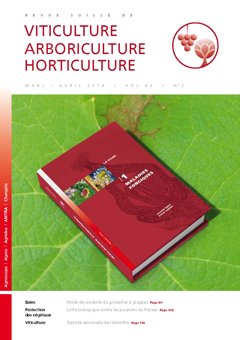
Issue 2 - March - April 2014
Abstract in open access
A trial carried out in Bruson and Conthey (VS, Switzerland) with several red currant varieties comparing the V-training system with the traditional training system (palmette) over seven years showed that the V-training system had little influence on yield and fruit quality, but a positive incidence on the harvesting speed. In Bruson, for cv. Tatran and Rovada, the harvesting speed gain exceeds 15 %. In Conthey, this gain is around 10 % for cv. Red Poll and Jonkheer van Tets. This has a considerable impact on the crop’s profitability. For the variety Rovada grown in Bruson, the productivity gain compared with palmette exceeds 30 %, what means CHF 16 600.– per hectare.
Keywords: redcurrants, varieties, tree training, Drilling, tree-cane espalier
E-Mail: andre.ançay@agroscope.admin.ch
Adress: Agroscope, 1964 Conthey
Abstract in open access
A cocktail of six species of parasitoids was used in Switzerland and France to control aphids in protected and soilless strawberry crops. The cocktail FresaProtect was developed by Viridaxis in Belgium. In Switzerland, this cocktail was tested during two years under tunnel on everbearing strawberries. The first year, the parasitoids started to develop too late in the season and the aphid population could not be brought under control. The second year, with parasitoids releases starting earlier in the season, the aphid population was under control. Four chemical treatments were applied in the control plot while none was needed in the trial tunnel. In France, this cocktail of parasitoids was tested during three years in heated greenhouses on everbearing strawberries in soilless culture. In the first year, a cocktail of five species of parasitoids was not sufficient to control the aphid population. In the second and third year, the cocktail contained six species of parasitoids and the aphid population was finally under control when the releases started before the aphids apparition. When applied at the right time, FresaProtect may be an efficient tool in IPM strategy.
Keywords: aphids, biological control, parasitoids, strawberry
E-Mail: catherine.baroffio@agroscope.admin.ch
Adress: Agroscope, 1964 Conthey
Abstract in open access
Nested PCR and real time PCR are routinely used techniques for the diagnosis of phytoplasma-related diseases in fruit growing. The first variant, used in Agroscope’s laboratory of phytoplasmology, in Changins, was compared to the second variant, using one hundred and sixteen apple, pear and apricot trees. The test shows that real time PCR is more accurate than nested PCR, but marginally so. This small difference may have significant impact on the production of certified fruit plant material. However, the main factor determining the extent of the imprecision appears to be linked to the type of sampling chosen.
Keywords: Candidatus phytoplasma mali, Candidatus phytoplasma pyri, Candidatus phytoplasma prunorum, apple proliferation, pear decline, European stone fruit yellows, apple, pear, apricot
E-Mail:
Adress:
Abstract in open access
Absinth producers of the Val-de- Travers (NE, Switzerland) region would like to see their brandy labelled with a Protected Geographical Indication (PGI) Val-de-Travers. The University for Viticulture and Oenology Changins defined the typical sensory characteristics of Absinth in a joint project in 2012, in order to create an appropriate tasting sheet, to train the tasters and to implement the tasting for the label approval. Absinth products from the Val-de- Travers differ from those of other regions in Switzerland or abroad by their sensory typicity. The newly developed sensory analysis methodology allowed to select the products made according to the Absinth specifications established by the Val-de-Travers region.
Keywords: Absinth, Protected Geographical Indication (PGI), typicity, tasting, agreement
E-Mail: pascale.deneulin@changins.ch
Adress:
Abstract in open access
Lactic acid bacteria have stringent nutritional requirements. A lack of suitable nutrients can delay or prevent the onset of MLF. This work evaluated the composition of various nutrient formulations intended for bacteria, as well as their effect on bacterial viability. The analysis of elements, amino acids and vitamins revealed significant variations among these products and their effect on bacterial viability was strain dependent. A correlation between the vitamin B5 content in one nutrient and its effect on the viability of three bacterial strains could be established. The results also highlight the importance of proper storage conditions of nutrients on the concentration of vitamins that are essential for wine bacteria.
Keywords: wine, lactic acid bacteria, nutrients, malolactic fermentation, amino acids, vitamin
E-Mail: ramon.mira@changins.ch
Adress:

 Download of full issue
Download of full issue
 Download article
Download article